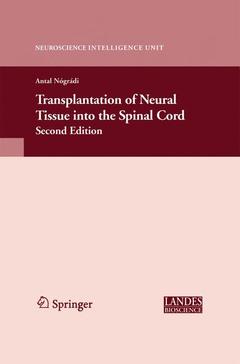Description
Transplantation of Neural Tissue into the Spinal Cord (2nd Ed., 2nd ed. 2006)
Neuroscience Intelligence Unit Series
Coordinator: Nogradi Antal
Language: English
Subjects for Transplantation of Neural Tissue into the Spinal Cord:
Transplantation of Neural Tissue into the Spinal Cord (2nd Ed.)
Publication date: 12-2014
150 p. · 15.5x23.5 cm · Paperback
Publication date: 12-2014
150 p. · 15.5x23.5 cm · Paperback
Transplantation of neural tissue into the spinal cord, 2ed
Publication date: 01-2006
150 p. · 15.6x23.4 cm · Hardback
Publication date: 01-2006
150 p. · 15.6x23.4 cm · Hardback
Description
/li>Contents
/li>Comment
/li>
The book gives an account of results obtained from experiments where grafts of neuronal, glial and other tissues as well as artificial materials were placed into the spinal cord. It attempts to evaluate the contributions made by these studies to our understanding of basic neurobiologies questions. These include factors that regulate neuronal growth during development as well as regenera tion following injury to the nervous system. The model of neural transplanta tion is also useful for the study of cell-to-cell interactions, and this applies to interactions between glial cells and neurones, between various populations of neuronal cells and finally between axons and skeletal muscle fibres. The mecha nisms involved in the establishment of specific synaptic connections between neurones can also be investigated in this experimental paradigm. Important in formation regarding this issue was also obtained on systems other than the spinal cord, i. e. the cerebellum, hippocampus and striatum. Although such in formation of precise connections between the host and the grafted embryonic tissue is still lacking in the spinal cord, there is much information on the re sponse of the host nervous system to the grafted embryonic tissue, and that of the graft to its new host environment. It appears that embryonic grafts are able to induce repair processes follow ing injury to the nervous system.
Anatomy and Physiology of the Spinal Cord.- Recovery of Function After Spinal Cord Injury.- Recovery of Lost Spinal Cord Function by Facilitating the Spinal Cord Circuits Below the Lesion.- Encouraging Regeneration of Host Neurons:.- Encouraging Regeneration of Host Neurons:.- Replacement of Specific Neuronal Populations in the Spinal Cord.- Replacement of Specific Populations of Cells.- Conclusion.
Designed to bridge the gap between basic researchers and clinical practitioners in thie field Reflects the present state of the art of the subject, where there is a great body of morphological, immunocytochemical and molecular information available as to the events that occur during graft-host interactions, but not enough literature
© 2024 LAVOISIER S.A.S.
These books may interest you

Glial Physiology and Pathophysiology 140.84 €



